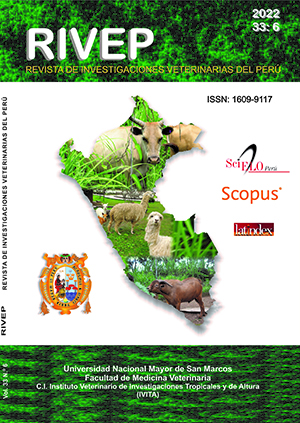Lactation curves of Holstein x Gyr dual-purpose cows under humid tropical conditions
DOI:
https://doi.org/10.15381/rivep.v33i6.22510Keywords:
breed group, lactation peak, Sikka, Wilmink, Wood modelAbstract
The aim of this study was to identify the foremost model that depict the lactation curve of dual-purpose crossbred cows under a humid tropical environment. Six models were compared to describe the lactation curves of three breed groups using 1231 milk records of 160 cows. The breed groups were 0-25%, F1 (50%) and 62.5-75% Holstein x Gyr crosses. Parameters of the models and curves were estimated using non-linear procedures. The best model was determined by the Akaike information criterion. Wood, Sikka and Wilmink models provided a good fit to the lactation curves for the breed groups; however, the Wood model was applied to depict the lactation curves, the day at which lactation peak was reached and milk yield at the peak. The aspect of the curves differed according to the breed group. The low graded Holstein cows had typical standard curves, and the F1 and high graded cows had no lactation curve peak. Milk yield at start of lactation increased as the Holstein blood increased. The rate of milk per day was close to zero (0.0813 for 0-25% Holstein cows; 0.0247 for F1 and 0.0023 kg/day for 62.5-75% Holstein cows). The aspect of the lactation curve varied depending on the non-linear model and the grade of Holstein. The shapes of the lactation curves vary according to the breed group from normal to without peak milk yield.
Downloads
Downloads
Published
Issue
Section
License
Copyright (c) 2022 Jorge Alonso Peralta-Torres, Yuliana Izquierdo-Camacho, Nadia Florencia Ojeda-Robertos, Víctor Hugo Severino-Lendechy, Jesús Enrique Ek-Mex, José Candelario Segura-Correa

This work is licensed under a Creative Commons Attribution 4.0 International License.
AUTHORS RETAIN THEIR RIGHTS:
a. Authors retain their trade mark rights and patent, and also on any process or procedure described in the article.
b. Authors retain their right to share, copy, distribute, perform and publicly communicate their article (eg, to place their article in an institutional repository or publish it in a book), with an acknowledgment of its initial publication in the Revista de Investigaciones Veterinarias del Perú (RIVEP).
c. Authors retain theirs right to make a subsequent publication of their work, to use the article or any part thereof (eg a compilation of his papers, lecture notes, thesis, or a book), always indicating the source of publication (the originator of the work, journal, volume, number and date).










